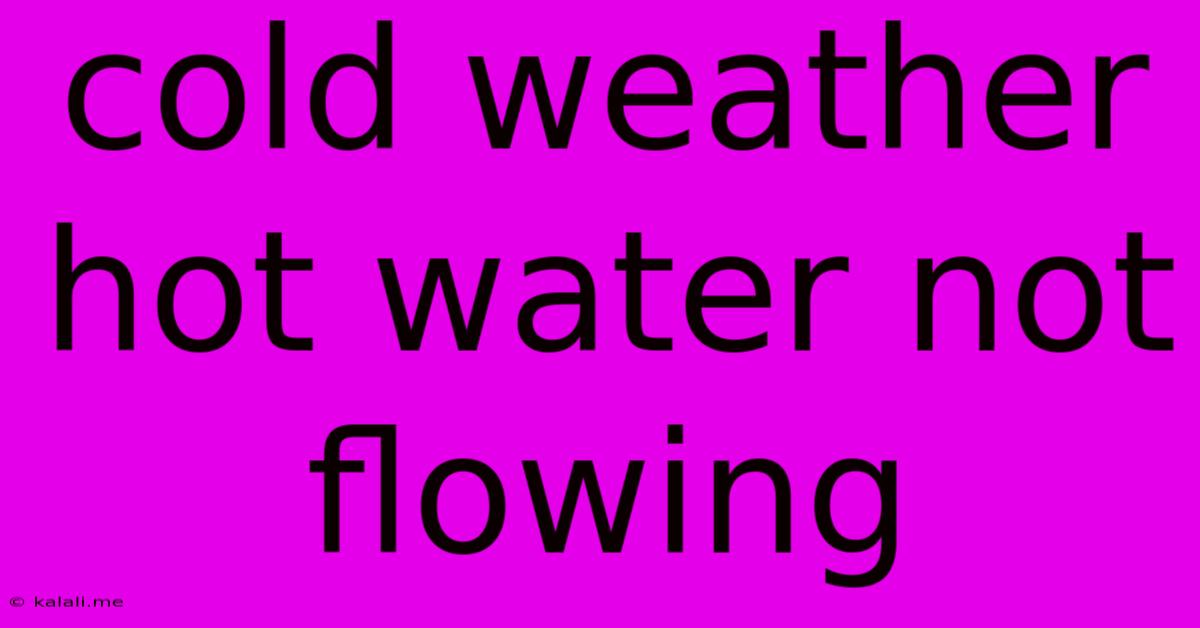Cold Weather Hot Water Not Flowing
Kalali
Jun 05, 2025 · 4 min read

Table of Contents
Cold Weather Hot Water Not Flowing: Troubleshooting and Solutions
Meta Description: Experiencing cold showers in the winter? This guide explores common reasons why your hot water isn't flowing in cold weather, offering troubleshooting steps and solutions to get your hot water back on.
Winter's chill can be intensified by a sudden lack of hot water. A perfectly functioning hot water system in warmer months might falter when temperatures plummet. This isn't necessarily a major plumbing disaster; several relatively simple issues could be the culprit. This article will guide you through troubleshooting common causes of cold water issues during cold snaps, helping you restore warmth and comfort to your home.
Understanding the Problem: Why Cold Weather Affects Hot Water
The primary reason your hot water might vanish in cold weather is related to water temperature and pipe freezing. Cold temperatures can cause water in your pipes to freeze, particularly exposed pipes in uninsulated areas like attics, crawl spaces, or exterior walls. Frozen pipes expand, potentially causing cracks or blockages that interrupt water flow. This is especially true for pipes carrying hot water, as they often run along the outside walls and are more susceptible to freezing.
Another contributing factor is the increased demand for hot water during winter. Longer showers, frequent handwashing, and dishwashing all increase the load on your water heater, which might struggle to keep up, especially if it's older or undersized for your household's needs.
Let's delve into the specific issues and solutions:
Troubleshooting Steps: Identifying the Source of the Problem
1. Check Your Water Heater:
- Pilot Light (Gas Water Heaters): Ensure the pilot light is lit. If not, relight it according to your water heater's instructions. A faulty thermocouple could also be preventing ignition.
- Thermostat Setting: Confirm the thermostat is set to the desired temperature. A low setting might not produce enough hot water, particularly during peak demand.
- Power Supply (Electric Water Heaters): Check that the breaker or fuse supplying power to your water heater hasn't tripped or blown.
- Water Level: For tank-type heaters, check the water level. A low water level will severely reduce hot water production. Consult your manual for instructions on refilling.
2. Inspect Your Pipes:
- Frozen Pipes: Carefully check pipes throughout your home, paying close attention to exterior walls, attics, and crawl spaces. Frozen pipes often feel hard and may be bulging. Never attempt to thaw frozen pipes with a blowtorch or open flame. Use a hairdryer or heating pad instead. A slow, gradual thaw is crucial to prevent pipe damage.
- Leaks: Look for any signs of leaks, especially near faucets and joints. Even small leaks can significantly reduce water pressure and hot water availability.
3. Examine Faucets and Fixtures:
- Airlocks: Sometimes, airlocks can prevent hot water from flowing smoothly. Turn on all hot water taps in the house for several minutes to purge any trapped air.
- Sediment Buildup: Mineral buildup in faucets and showerheads can restrict water flow. Cleaning or replacing these fixtures might resolve the issue.
4. Consider Your Water Pressure:
- Low Water Pressure: Low water pressure affecting both hot and cold water might indicate a wider issue, possibly related to the main water supply or a problem within the water meter. Contact your water company or a plumber if you suspect this.
Solutions and Preventative Measures
- Insulate Exposed Pipes: Adding pipe insulation is a highly effective preventative measure. Insulation helps maintain water temperature and reduces the risk of freezing.
- Maintain Your Water Heater: Regularly flush your water heater to remove sediment buildup, which can reduce efficiency and lifespan.
- Preventative Maintenance: Schedule regular maintenance checks for your entire plumbing system, especially before the onset of winter.
- Keep Your Home Warm: Maintaining a consistently warm indoor temperature minimizes the risk of frozen pipes.
- Let Water Drip: During exceptionally cold periods, let a slow trickle of cold water run from faucets in vulnerable areas to keep pipes from freezing.
If you've followed these steps and still have no hot water, it's best to contact a qualified plumber. They possess the expertise and tools to diagnose and repair more complex plumbing issues. Don't hesitate to seek professional help—a quick fix is often cheaper than the damage caused by a neglected problem.
Latest Posts
Latest Posts
-
How To Exit Power Armor Fallout 4 Xbox
Jun 06, 2025
-
How Do You Test A Fuel Pressure Regulator
Jun 06, 2025
-
Rsync Delete Files Not In Source
Jun 06, 2025
-
How Long Does Pvc Pipe Last
Jun 06, 2025
-
Can You Put Water In Your Coolant Tank
Jun 06, 2025
Related Post
Thank you for visiting our website which covers about Cold Weather Hot Water Not Flowing . We hope the information provided has been useful to you. Feel free to contact us if you have any questions or need further assistance. See you next time and don't miss to bookmark.